

12mR – GRETEL – Recreate of 1962 America´s Cupper
Preis auf Anfrage
- Description
- Additional information
Specification
General Information
Rigg and Sails
Construction
One outstanding classic yacht of America’s Cup fame is now available for restoration at Robbe & Berking Classics yard in Flensburg. The 12-m-R yacht GRETEL sailed as a challenger for the America’s Cup in 1962. It was the first ever Australian 12mR. GRETEL was designed by the yacht designer Alan Payne. Her hull was built of wood on steel frames.
The 12 metre designed by Alan Payne was full of new ideas. A groundbreaking innovation was the ability to connect the genoa winches to one another via a four-speed gearbox and to operate them with foot pedals. This increased the efficiency when turning immensely.
The first ever Australian 12 metre was launched on February 19, 1962, seven months before the America’s Cup races. Nine days later the yacht was christened GRETEL in memory of Frank Packer’s deceased wife. Already with the first test strokes against “Vim” it became clear that “Gretel” was very fast. At the end of May 1962, both ships were sent to the USA, where “Gretel” later fought a tough and worthy battle with the defender, “Weatherly”. The races were exciting and were only narrowly won. The Australians won one race. After the cup races of 1962, the fast “Gretel” served as a sparring partner for later teams; 1967 for the challenger “Dame Pattie” and later for “Gretel II”, Packer’s second challenge from 1970. “Gretel” last sailed in 1975 in the first “Southern Cross” team.
From 1973 to 1974 it belonged to “Yanchep Estates Pty. Ltd. ”with home ports in Perth and Yanchep. In 1975 the “Southern Cross America’s Cup Challenge Association, Ltd.” owned the yacht, from 1976 to 1979 it belonged again to the “Gretel Syndicate” and in 1980 it was removed from Lloyd’s Register. From 1982 to 1994 she worked as a charter yacht in the Whitsundays, later she was sold to Europe and sailed for many years in Italy. It was found here by the Robbe & Berking Classics shipyard and is now being transported to the shipyard in Flensburg for a basic restoration. “We want to restore the ship to its original condition from 1962,” said shipyard manager Oliver Berking. “This is a unique piece of yachting history and must be preserved!”
Related products
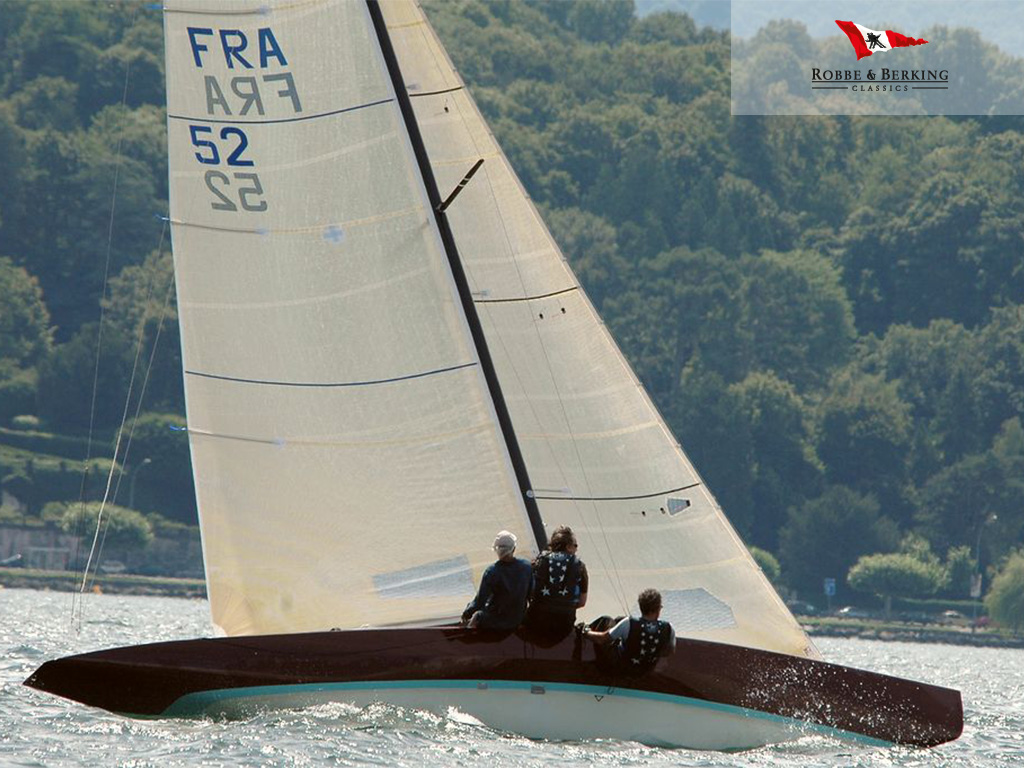
5.5mR Modern – Séb. Schmidt 2007 – STRADIVARIUS
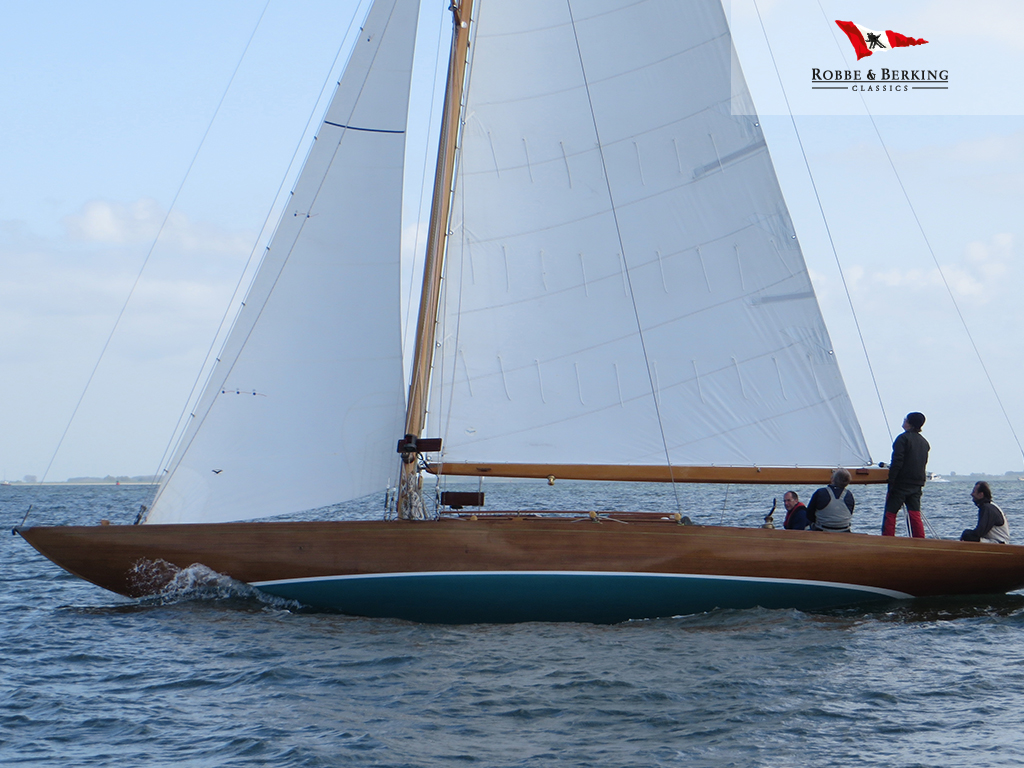
IDUNA – 1912 Johan Anker 9.5mR

Abeking & Rasmussen 16KR Yawl – ASGARD

Gretel II overshadows smaller yachts at the Port Cygnet Regatta
Gretel II turns 50 in Hobart
Hobart, April 10, 2020:
Gretel II, the famous Australian yacht that might well have won the America’s Cup in 1970, turned 50 today, the classic 12-Metre Class yacht sitting sedately in her marina berth at the Royal Yacht Club of Tasmania on Hobart’s River Derwent.
Gretel II was launched in Sydney on April 10 in 1970 for media magnate Sir Frank Packer, built by Bill Barnett to a design by Alan Payne. She was the last America’s Cup boat to be built of wood.
She is now owned by NSW yachtsman Mike Maxwell who commissioned a major refit in New Zealand in 2009. Maxwell decided to relocate GII (as she became known) at the RYCT, his reasoning being that the open waters of the River Derwent were more suited to sailing a 12-Metre than on Sydney Harbour.
She recently contested the Port Cygnet Regatta down the D’Entrecasteaux Channel, winning the passage races from Hobart to Kettering and Kettering to Port Cygnet, with Maxwell flying into Tasmania to skipper the crew of RYCT members headed by Steven Shield.
Sir Frank Packer had first challenged for the America’s Cup with Gretel in 1962, returning to Newport, Rhode Island in 1970 with the new and innovative Alan Payne design.
After defeating Baron Bich’s France in the challenger selection series 4-0, Jim (now Sir James) Hardy took on the New York Yacht Club’s defender Intrepid, skippered by US Olympian Bill Ficker.
Intrepid won the first race when Gretel II’s David Forbes was swept overboard. He managed to hang onto a sheet and scrambled back on board.
Then, in a controversial second race, Gretel II crossed the finish line first, but was subsequently disqualified due to a collision at the start, a decision that angered Packer.
Intrepid won the third race, but Gretel II recorded a win in race four by 1 minute and 2 seconds. Intrepid went on to win the fifth race and retain the America’s Cup for the New York Yacht Club 4-1.
Many observers, including the 1977 America’s Cup US skipper Ted Turner, believed that Gretel II was a faster boat but that the cunning tactics of Bill Ficker and skills of the American crew was the deciding factor in Intrepid’s win.
Among Gretel II's cre , as port trimmer, was John Bertrand who in 1983 skippered the Alan Bond-financed Australia II to victory in the America’s Cup.
Gretel II was used as a trial horse for Bond’s Southern Cross in 1974 and in the 1977 America’s Cup she returned to the fore as one of four yachts vying to be the Challenger for the ‘Auld Mug’.
Skippered by Gordon Ingate, Gretel II’s veteran crew became known as ‘Dad’s Army’, but the team was eliminated in the trials. Returned to Sydney and the Royal Sydney Yacht Squadron, the 12-Metre was restored by a group of yachting enthusiasts but became neglected again until bought by Mike Maxwell.
In Hobart today, prominent yachtsman Steven Shield commented on Facebook: “I have had the absolute privilege of being the team leader to sail her and oversee her ongoing maintenance,” adding his thanks to Adam Goode, Rod Chamberlain and his team at Hurricane Marine, Michael Vincent, Mathew Wand Jane Foster, Swiftshore, and all his sailing friends who have helped get her out sailing.
“We did have a special birthday party planned for GII but the coronavirus put a big stop to that,” Shield said, adding: “If you have access to the locked RYCT marina, head out and give her a pat today.”
Words: Peter Campbell, Steven Shield, references Wikipedia and its various sources, including Peter Campbell who covered the America’s Cup Challenge Matches as a yachting journalist from 1974 through to 1987. He was a member of the onshore team (media) with Gordon Ingate’s bid in 1977.
ALSO ON MYSAILING

2024 NSW O’pen Skiff Championships

Best of the best to contest national yachting title in Newcastle

OGR – Winners and Losers on Leg 4
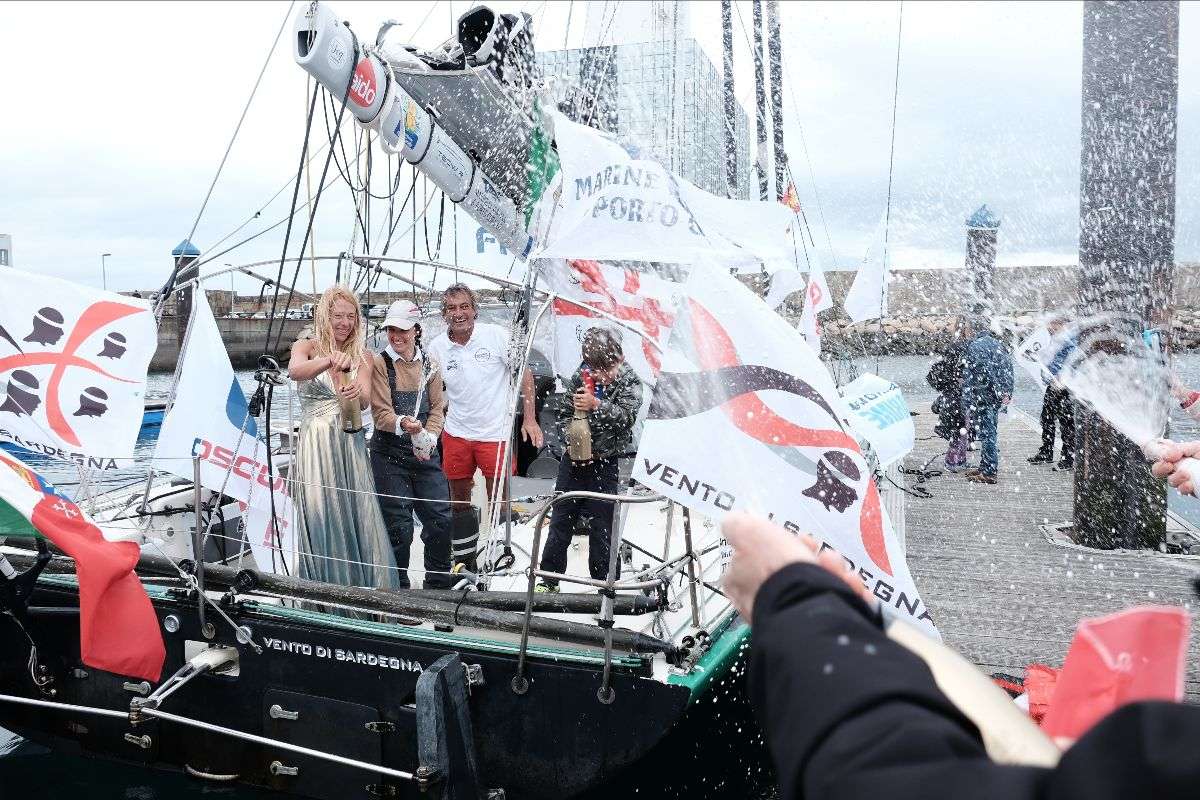
GSC – Andrea Mura reclaims joy on podium
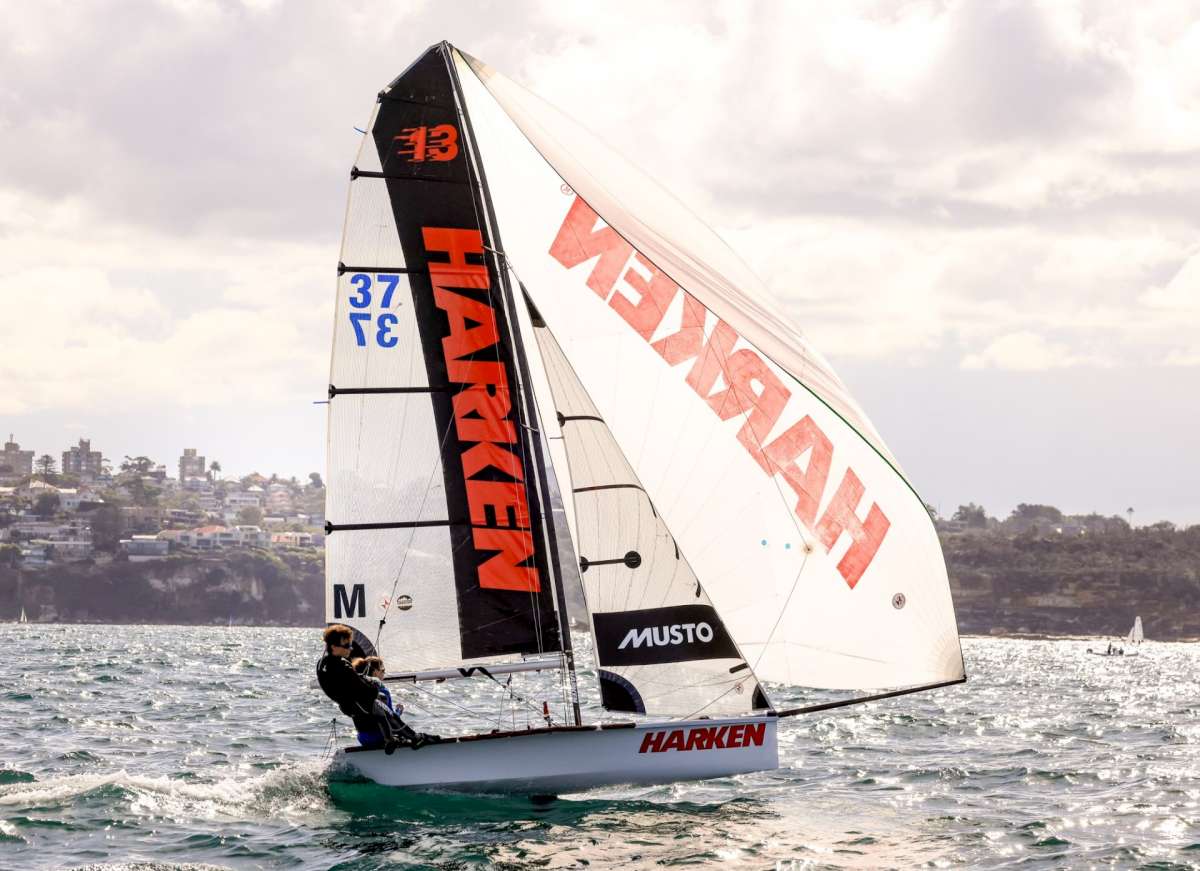
Final Club Championship results at Manly 16ft Skiff Sailing Club
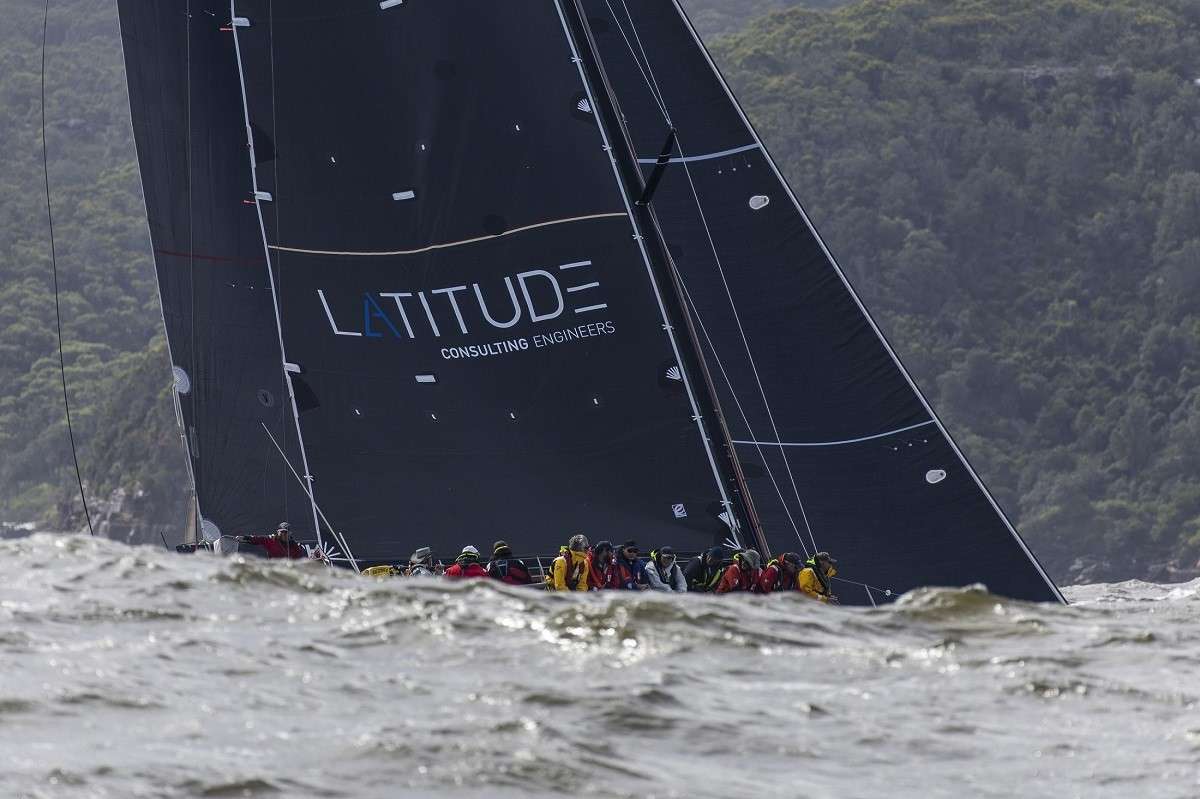
Race is on to win 2024 Pittwater to Coffs Harbour Yacht Race

Outteridge takes the wheel as Schneiter steps back for remainder of Season 4
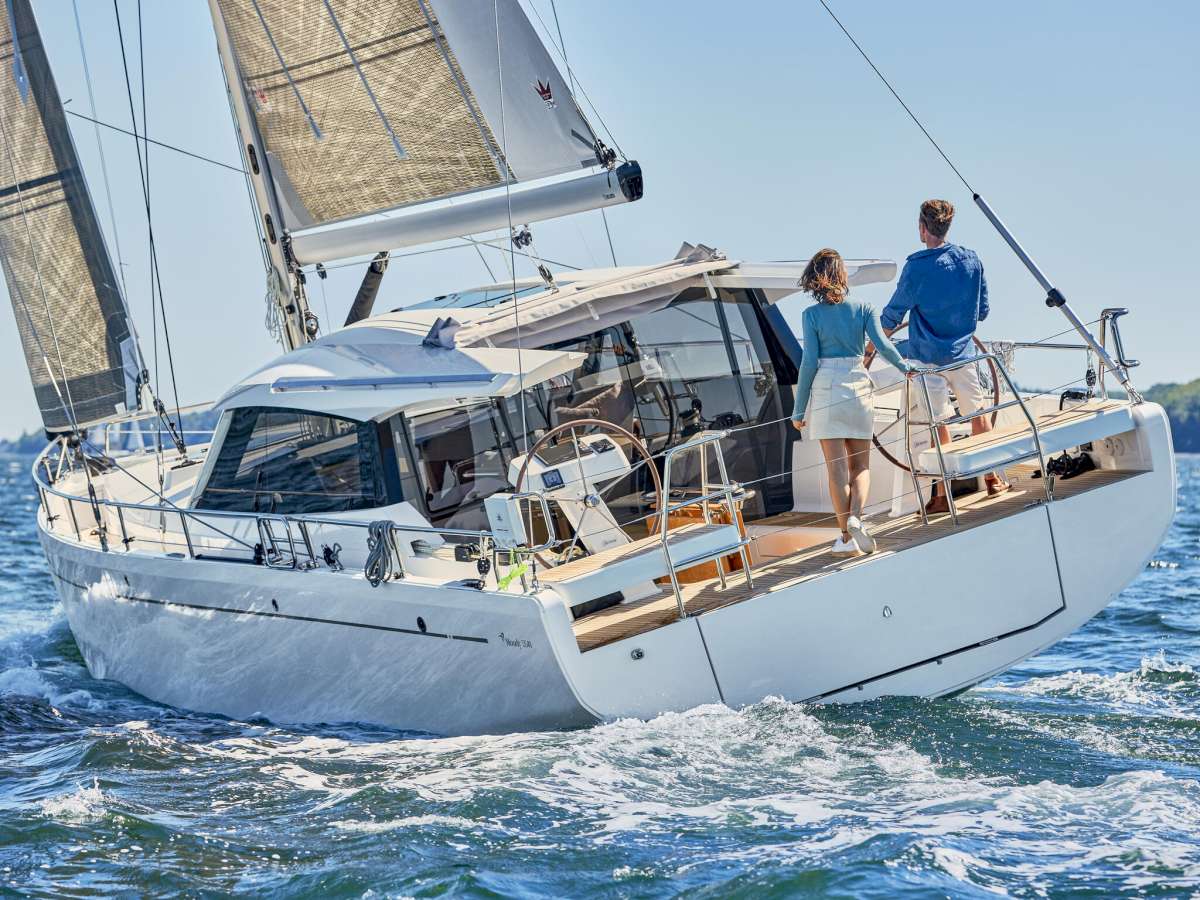
Windcraft presents award-winning sail and power line-up at 2024 Auckland Boat Show

Step into the World of Exploration Boating with the RAND Roamer 29

Tasmanian Sailing – Weekend Wrap

12ft Skiff – Father and son finish top two in NSW Sprint Championship

BYS Women’s Sportsboat Regatta – Day 2

Join Our Newsletter
- Name First Last
- Email This field is for validation purposes and should be left unchanged.

Read all of the latest sailing news

Dinghy and Yacht Racing News

News from the offshore world

Cruising Stories from around the world

Boats & Gear
The latest boats and yachting gear

Watch everything sailing and boating
Latest Sailing News, Racing, Cruising, Boats, Gear and more

- CLASSIFIEDS
- NEWSLETTERS
- SUBMIT NEWS

Launch of 12 Metre 'Gretel' in Sydney for America's Cup
Submitted by british pathé , showing footage from 1962 *.
This video was used in a news article:
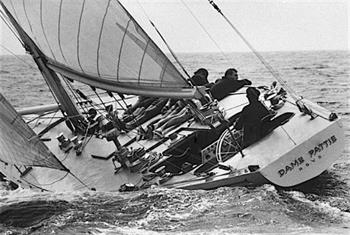
- Other videos from the same person/organisation
- Other videos from [???] class
- Other videos from [???] club
- Trending videos in your region
- Search or browse all videos

History in Pieces
- Presidential Approval Ratings
- Nuclear Weapons
- Opinion Polls
- NSC Meetings
- Miscellaneous
- White House Tapes
- About & Disclosure
Australian America’s Cup Yacht Buzzed by the US Navy during the Cuban Missile Crisis
by David Coleman
The 1962 America’s Cup was held just a month before the Cuban missile crisis at Newport, Rhode Island. The Australian challenger yacht Gretel went up against the yacht from the New York Yacht Club, the Weatherly . Gretel was the first Australian challenger, the first America’s Cup challenger from a country other than Britain or Canada, and the first from the southern hemisphere. It was owned by a syndicate headed by media magnate Sir Frank Packer ( Kerry Packer ‘s father and James Packer ‘s grandfather).

Sir David Ormsby-Gore (Lord Harlech)
I know that all of us take the greatest pleasure in being here, first of all because whether we’re Australian or American, we are all joined by a common interest, a common devotion and love for the sea. And I am particularly glad to be here because this Cup is being challenged by our friends from Australia, this extraordinary group of men and women numbering some 10 million, who have demonstrated on many occasions, on many fields, in many countries, that they are the most extraordinary athletic group in the world today, and that this extraordinary demonstration of physical vigor and skill has come not by the dictates of the State, because the Australians are among the freest citizens in the world, but because of their choice. Therefore, Ambassador, you are most welcome here. This Cup has been challenged in the past by our friends from Great Britain. We are glad to see Australia assuming the responsibilities of empire in coming here, and we’re particularly glad to welcome you in the year 1962. This is a trophy which the United States has held for over a century, unlike the Davis Cup. And we do have a feeling, Ambassador, we do have an old American motto of “One cup at a time.” There is no question that this kind of national competition produces the greatest good will among nations. The most recent indication of that, of course, were the games held at Indonesia which produced a wonderful feeling of spirit in all of Asia, and I am confident that these games will produce the same kind of good will between Australia and the United States. 2 I really don’t know why it is that all of us are so committed to the sea, except I think it’s because in addition to the fact that the sea changes, and the light changes, and ships change, it’s because we all came from the sea. And it is an interesting biological fact that all of us have, in our veins the exact same percentage of salt in our blood that exists in the ocean, and, therefore, we have salt in our blood, in our sweat, in our tears. We are tied to the ocean. And when we go back to the sea–whether it is to sail or to watch it–we are going back from whence we came. Therefore, it’s quite natural that the United States and Australia, separated by an ocean, but particularly those of us who regard the ocean as a friend, bound by an ocean, should be meeting today in Newport to begin this great sea competition. This is an old relationship between the United States and Australia, and particularly between Rhode Island and Australia. In the 1790’s, Ambassador, American ships, mostly from Rhode Island, began to call regularly at New South Wales. Their cargoes, I regret to say, consisted mainly of gin and rum, and the effect was to set back the athletic development, until the recent great temperance movement in Australia, for many years. In 1801, Governor Philip Gidley King of Australia complained to London, “Such has been the certainty in America of any quantity of spirits being purchased here that a ship cleared out of Rhode Island for this port with a very large investment of spirits, which I positively forbade being landed, in consequence of which she left this port with upward of 13,000 gallons of spirit brought to Australia for sale.” And he told the American Minister Rufus King to warn the Rhode Island merchants not to try to market their rum in Australia. I need hardly say that the Rhode Island merchants continued to do their compassionate best to quench this thirst which was felt so strongly in Australia. However, Australia became committed to physical fitness and it’s been disastrous for the rest of us. We have the highest regard for Australia and we, as you said, Ambassador, regard them as very satisfactory friends in peace and the best of friends in war. And I know that there’re a good many Americans of my generation who have the greatest possible reason to be grateful to the Australians who wrote a most distinguished record all the way from the desert of North Africa, and most particularly in the islands of the South Pacific, where their particular courage and gallantry I think met the strongest response in all of us in this country. But I don’t really look to the past. I look to the present. The United States and Australia are most intimately bound together today, and I think that–and I speak as one who has had some experience in friendship and some experience in those who are not our friends–that we value very much the fact that on the other side of the Pacific the Australians inhabit a very key and crucial area, and that the United States is most intimately associated with them. So beyond this race, beyond the result, rests this happy relationship between two great people. I want to toast tonight the crew, the sailors, those who made it possible for the Gretel to come here, those who have, for a hundred years, defended this Cup from the New York Yacht Club, to all of them. As the Ambassador said so well, they race against each other, but they also race with each other against the wind and the sea.
The next day, JFK and Jackie Kennedy boarded the Destroyer USS Joseph P. Kennedy Jr. (named after his elder brother who had been killed in World War II) to watch the first race from the ship’s deck in the sunshine. The Weatherly won.

JFK and Jackie Kennedy watch the first race in the 1962 America’s Cup from aboard the USS Joseph P. Kennedy Jr., off Newport, Rhode Island. Photograph by Robert Knudsen, White House, in the John F. Kennedy Presidential Library and Museum, Boston. 15 September 1962 / KN-C23943
Three days later, Gretel fought back to level the series 1-1. It ended up being the only race of the series that Gretel won. Weatherly won the following three races, securing the cup yet again for the United States on September 24, 4 wins to 1.
“[W]e have salt in our blood, in our sweat, in our tears. We are tied to the ocean. And when we go back to the sea–whether it is to sail or to watch it–we are going back from whence we came.” Getting Gretel home to the Royal Sydney Yacht Club wasn’t a case of simply setting sail off into the wild blue yonder. 12-meter yachts are designed for inshore match racing, not ocean crossings. So to get it home half-way around the world they had to load it on a freighter and ship it back.
But it wasn’t all smooth sailing. As they headed south they found the U.S. Navy paying special attention to freighters heading into the Caribbean. The freighter, the Port Wyndham , had set sail from New York on October 23. That same day, on President Kennedy’s order, the U.S. Navy instituted a blockade line to stop ships going to Cuba . It was the darkest period of the Cuban missile crisis , and along with every other freighter in Caribbean waters during the period, the ship carrying the Gretel came in for special attention from the U.S. military.
The Port Wyndham , carrying the Gretel , did not make it back to Sydney until mid-December. When they finally arrived, the crew told reporters of their brush with the Cuban missile crisis half-way around the world. As the Associated Press report put it in a December 19 report:
The crew of the freighter Port Wyndham, which brought the Australian yacht Gretel home from the America’s Cup competition, reported today they were buzzed repeatedly near Cuban waters by U.S. military aircraft. The freighter sailed from New York on October 23 and passed through the Caribbean during the Cuban crisis. 3
- “Remarks in Newport at the Australian Ambassador’s Dinner for the America’s Cup Crews,” 14 September 1962, Public Papers of the Presidents: John F. Kennedy: 1962 (Washington, DC: Government Printing Office, 1963), doc. 383. ↩
- The 4th Asian Games were held from August 24, 1962 to September 4, 1962 in Jakarta, Indonesia. ↩
- Associated Press, “Yacht Carrier Buzzed Off Cuba,” Washington Post , 12 December 1962. ↩
About David Coleman
Follow at Medium . Read More »
Gretel (yacht)
Gretel is an Australian racing yacht in the 12-metre class that unsuccessfully challenged for the 1962 America's Cup .
Gretel lost to Weatherly by 1–4. [1]
Related Research Articles

Edson Arantes do Nascimento , known as Pelé , is a Brazilian former professional footballer who played as a forward. Regarded as one of the greatest players of all time, and labelled "the greatest" by FIFA, he was among the most successful and popular sports figures of the 20th century. In 1999, he was named Athlete of the Century by the International Olympic Committee and was included in the Time list of the 100 most important people of the 20th century. In 2000, Pelé was voted World Player of the Century by the International Federation of Football History & Statistics (IFFHS), and was one of the two joint winners of the FIFA Player of the Century. His 1,279 goals in 1,363 games, which includes friendlies, is recognised as a Guinness World Record.
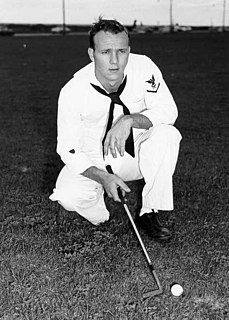
Arnold Daniel Palmer was an American professional golfer who is widely regarded as one of the greatest and most charismatic players in the sport's history. Dating back to 1955, he won numerous events on both the PGA Tour and the circuit now known as PGA Tour Champions. Nicknamed The King , Palmer was one of golf's most popular stars and seen as a trailblazer, the first superstar of the sport's television age, which began in the 1950s.

The National Soccer Hall of Fame is a private, non-profit institution established in 1979 and currently located in Toyota Stadium in Frisco, Texas, a suburb of Dallas. The Hall of Fame honors soccer achievements in the United States. Induction into the hall is widely considered the highest honor in American soccer.

The America's Cup , informally known as the Auld Mug , is a trophy awarded in the sport of sailing. It is the oldest international competition still operating in any sport. America's Cup match races are held between two sailing yachts: one from the yacht club that currently holds the trophy and the other from the yacht club that is challenging for the cup. Matches are held several years apart on dates agreed between the defender and the challenger. There is no fixed schedule, but the races have generally been held every three to four years. The most recent America's Cup match took place in March 2021.
The European/South American Cup , more commonly known as the Intercontinental Cup and from 1980 to 2004 as the Toyota European/South American Cup for sponsorship reasons, was an international football competition endorsed by the Union of European Football Associations (UEFA) and the Confederación Sudamericana de Fútbol (CONMEBOL), contested between representative clubs from these confederations, usually the winners of the UEFA Champions League and the South American Copa Libertadores. It ran from 1960 to 2004, when it was succeeded by the FIFA Club World Championship, although they both ran concurrently in 1999–2000.

Intrepid is a 12-metre class racing yacht which won the America's Cup in 1967 and again in 1970.

Dame Pattie is an International 12-metre class racing yacht built for the America's Cup challenge series in 1967. She was designed by Warwick Hood and built by W.H. Barnett in New South Wales, Australia.
Paul Bogart was an American television director and producer. Bogart directed episodes of the television series 'Way Out in 1961, Coronet Blue in 1967, Get Smart , The Dumplings in 1976, All In The Family from 1975 to 1979, and four episodes of the first season of The Golden Girls in 1985. Among his films are Oh, God! You Devil , Torch Song Trilogy , Halls of Anger , Marlowe , Skin Game , and Class of '44 . He won five Primetime Emmy Awards during his long career, from sixteen nominations. In 1991, he was awarded the French Festival Internationelle Programmes Audiovisuelle at the Cannes Film Festival.
David John Oliver Forbes OAM was an Australian sailor who competed for his country at three Olympics from 1968 to 1976. Forbes won an Olympic gold medal in the Star Class at Munich 1972 alongside John Anderson OAM. His sailing career spanned over 20 years and included a 5.5m World Championship in 1970, a Sydney to Hobart race in 1974, and ten Australian championships in the Star, 5.5m, Soling, and Etchells classes. He represented Australia at three Olympic Games – 1968 Mexico City, 1972 Munich, and 1976 Montreal, and was a member of two America’s Cup challenges. He was a part of the ‘Gretel II’ crew in the 1970 America’s Cup and was relief helmsman in the 1977 America’s Cup.
Sailing/Yachting is an Olympic sport starting from the Games of the 1st Olympiad (1896 Olympics in Greece. With the exception of 1904 and the canceled 1916 Summer Olympics, sailing has always been included on the Olympic schedule. The Sailing program of 1956 consisted of a total of five sailing classes. For each class seven races were scheduled from 26 November to 5 December 1956 at Port Phillip Bay.

Joseph Egan was an English professional rugby league footballer who played in the 1930s, 1940s and 1950s, and coached in the 1950s, 1960s and 1970s. He played at representative level for Great Britain and England and Lancashire, and at club level for Wigan from 1938 to 1950, Oldham and Leigh, as a hooker, or second-row, i.e. number 9, or, 11 or 12, during the era of contested scrums, and coached at club level for Leigh, Wigan, Widnes, Warrington and Blackpool Borough. Egan is a Wigan Hall of Fame inductee, and was a life member at Wigan, Egan later became coach of Wigan, taking them to Championship success in the 1959–60 season.

The Payne–Mortlock Sailing Canoe is a 5.8m, two person, senior racing dinghy, rigged with a mainsail, jib and spinnaker. Designed in the mid-late 1940s by Alan Payne,, Bill Payne and Bryce Mortlock, the class has been sailed in Australia for over 50 years, and is one of the few senior classes that were designed within Australia.
Sir William Gaston Walkley was a New Zealand oil company executive. Walkley was a founder of Australian oil company Ampol and was credited with being one of the early pioneers in opening up the northwest of Australia to oil exploration. In 1956 he instituted the Walkley Awards, the premier award for excellence in Australian journalism.

The 1962 America's Cup, the second to be sailed in 12-metre yachts, marked the first challenge for the Cup from a country other than Great Britain or Canada, and was the first challenge from a country in the southern hemisphere. An Australian syndicate headed by Sir Frank Packer, representing the Royal Sydney Yacht Squadron, challenged with their yacht Gretel. Although the New York Yacht Club won the regatta four races to one represented by the yacht Weatherly, the challenger, Gretel won the second race, beating the Americans for the first time since the 1930s, and only lost the fourth race by twenty-six seconds. The NYYC was so shocked at the closeness of the contest that they immediately changed the rules to ban the use of American design and technology by Cup challengers.

Hansel & Gretel: Witch Hunters is a 2013 dark fantasy action horror film written and directed by Tommy Wirkola. It is a continuation to the German folklore fairy tale "Hansel and Gretel", in which the titular siblings are now grown up and working as a duo of witch exterminators for hire. The film stars Jeremy Renner and Gemma Arterton in the title roles with Famke Janssen, Peter Stormare, Thomas Mann, Pihla Viitala and Derek Mears as the supporting cast.
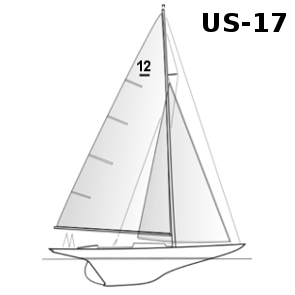
Weatherly is a 12-metre racing yacht that was an unsuccessful defense candidate for the 1958 America's Cup and victorious defender in the 1962 America's Cup.

Gretel II (KA-3) is an International 12-metre class racing yacht built for the America's Cup challenge series in 1970. She was designed by Alan Payne and built by W.H. Barnett for Australian media tycoon Sir Frank Packer.

The 1967 America's Cup was held in September 1967 at Newport, Rhode Island. The US defender, Intrepid , skippered by Bus Mosbacher, defeated the Australian challenger, Dame Pattie , skippered by Jock Sturrock, four races to zero.
Constellation is an American 12-metre class racing yacht that successfully defended the 1964 America's Cup.

The Packer family has played a significant role in the Australian media, political and social sphere since the beginning of the twentieth century.

The 12m Class and the America’s Cup By Halsey C. Herreshoff
Credit: www.herreshoff.org
The 150-year history of the America’s Cup, the oldest and most distinguished prize in world sport, is summarized from the author’s vantage point of belonging to a family of boat designers and builders who contributed to the dominance of American yachts from the beginning into the 1980s. Particulars and performances of the most important designs are described from AMERICA to the current International America’s Cup Class.
Introduction
The America’s Cup is the Holy Grail of yacht racing. It is much more. This Cup, in competition for a period of 150 years, is the oldest and most distinguished trophy in all sport, outdating the World Cup, Davis Cup, Stanley Cup, Walker Cup, and all others of significance. Excepting the lavish excesses of big time modern professional sport, more talent, effort, and money have been devoted to the America’s Cup than for any other sport competitions. From the standpoint of naval architecture, America’s Cup intensity has inspired countless design breakthroughs, fallout from which benefit all yachts today to an extent generally unrealized by those who sail. Here, a highly focused pursuit of excellence has provided quality, boldness, and dedication to be the best. The most elegant hull lines, most efficient construction, best sails, and most skillful sailing techniques have evolved from America’s Cup competition.
For 132 years (1851 to 1983), the United States enjoyed the longest winning streak in all sport. There were close calls but always the U.S. won the series and most of the individual races. Through that time, American yachts were generally, though not always, the fastest; thus, it may be fairly stated that victories followed very much from technical prowess.
As with any ship design, a sailing yacht embodies many necessary elements, which must dovetail to accomplish its mission. What is nice about America’s Cup design is that the only mission is speed, maneuverability and reliability to best a single match race rival around a closed course. Size, weight, wetted surface, hull form, light but strong construction, efficient rigs with good sails, sea kindliness and maneuverability are necessary. In general the successful boats embody acceptable or superior selections in the above categories. Bold innovation has been rewarded, but nearly always, extremes have failed. In a series of yacht races encompassing generally a variety of wind and sea conditions, an overall good boat wins.
It is appropriate to divide America’s Cup history into seven logical chronological divisions. The outstanding or most interesting yacht of each period will be addressed herewith. Listed below are the America’s Cup competitions by era with the names of the winning and defeated yachts respectively. In each case the focus yacht is in boldface type.
The l2-Metre era: 1958-1987
Following World War II, the conventional wisdom on both sides of the Atlantic was that the America’s Cup was done. The world was rebuilding and there seemed little prospect of funding further J boats given their assumed greatly accelerated cost. The Cup itself remained the pride of the New York Yacht Club, continually on display in the trophy room of the 44th Street Club House. Most of us expected it to just remain there for a long time, perhaps never to be raced for again.
Enter Commodores Henry Sears and Henry Morgan of the New York Yacht Club. By petitioning the Supreme Court of the State of New York, they modified the Deed of Gift to allow smaller yachts without the previous demand that challengers must cross the ocean on their own bottoms. It was agreed to compete in the International 12-Metre Class, which had provided excellent racing for several years before the war. Designed to the rather tight specifications of the International Rule, these boats did not really fit the grand traditions of the Cup but nevertheless provided nearly three decades of some of the finest match racing ever.
1958-1987: The 12-Metres 1958 COLUMBIA vs. SCEPTRE 1962 WEATHERLY vs. GRETEL 1964 CONSTELLATION vs. SOVEREIGN 1967 INTREPID vs. DAME PATTIE 1970 INTREPID vs. GRETEL II 1974 COURAGEOUS vs. SOUTHERN CROSS 1977 COURAGEOUS vs. AUSTRALIA 1980 FREEDOM vs. AUSTRALIA 1983 AUSTRALIA II vs. LIBERTY 1987 STARS & STRIPES vs. KOOKABURRA III
I can write more knowledgeably about the 12-Metre era than any other, as I was an active participant for 25 years and an observer for the full 29 years. Through acquaintance with Harry Sears, I was excused from other duties as a naval officer to sail aboard COLUMBIA, the 1958 Cup Defender, as bowman. Sailing aboard the 12’s in most of their seasons, I participated in four America’s Cup series, a total of 20 races; it was all about the greatest fun I’ve ever had.
The International Rule is an inelegant arbitrary formula that controls and restricts the design of these boats within narrow limits. There is a minimum length, maximum draft, maximum rig heights, and a set relation between length and displacement. Scantlings first in wood and later in aluminum are tightly controlled by specifics of the rule, Nevertheless, innovation in design particularly by Olin Stephens brought about nearly continual improvement of the boats, and the design edge of the United States long seemed to assure retention of the Cup as it did over many matches through 1980.
Curiously, some of the finest racing of all was in the finals of the first selection trials between COLUMBIA, sailed by Briggs Cunningham and designed by Sparkman & Stephens against Stephens prewar 12-Metre VIM. These were great tactical battles with racing margins of a few seconds in many races. The Cup race itself that year was a walk; SCEPTRE was a quite inferior design that had never faced competition before the match. As had happened a few times before, WEATHERLY, a weak American boat, won in 1962 by the brilliance of Bus Mobacher, her skipper. That was the first year of an Australian challenger and GRETEL won a race demonstrating the aggressive posture of Australian sailors.
Another S&S yacht, CONSTELLATION won in 1964. She was a quite elegant all-round boat, which was selected as Cup Defender over the large and powerful AMERICAN EAGLE, which was only superior in heavy weather. This should have been a tip off to the future but the true significance of having to design the smallest possible 12-Metre for Newport conditions was not generally appreciated until Australia II lifted the Cup in 1983. The reason 12-Metres form an exception to the axiom “design big” is the idiosyncrasy of the rule, particularly the prescription of increased displacement with length.
Olin Stephens’ INTREPID of 1967 was a breakthrough yacht. Wetted surface was drastically reduced with a shorter keel and separate rudder and the boat had numerous refinements. With outstanding management and the skill of Mosbacher again as skipper, INTREPID was unbeatable. The quest for further breakthroughs led to some peculiar and unsuccessful designs over the next two seasons.
The 1970 match was saved by repeat defense of INTREPID. In 1974, Olin Stephens designed another very fine boat, COURAGEOUS. Built of aluminum under new scantling rules, COURAGEOUS was powerful and superior in a breeze but did not easily defeat INTREPID, striving for a third defense. The selection trials reduced to a memorable sudden-death race in a 30-knot northeast breeze that COURAGEOUS won through both superior speed and better sailing. While I personally believe that Stephens’s 1977 boat, ENTERPRISE, was a further improvement in the same direction, Ted Turner sailing COURAGEOUS beat her out for the defense. Though not of demonstrably different dimensions, FREEDOM of 1980 seemed very superior. One difference was lower freeboard – providing a lower center of gravity and less hull windage. The new ingredient was a brilliant program of development of sails, gear and crew established by skipper Dennis Conner over a two-year program. The success of the program altered America’s Cup procedures from then on. Even with that, FREEDOM did lose one of the races of the match principally owing to a light-air advantage of Australia employing a rule-beating mainsail that gave her superior windward speed in light air.
Then, in 1983, the unthinkable happened in Newport when AUSTRALIA II beat LIBERTY in “The Race of the Century,” the sudden-death seventh race of that match. AUSTRALIA II was the best 12-Metre yacht to sail in the 25-year history of competition at Newport. Her extraordinary and controversial winged keel was, of course, the conspicuous feature. The ballyhoo about that masked the significant facts that AUSTRALIA II was the first boat to go to minimum 12-Metre length and displacement and that she had significantly less wetted surface than any other Twelve; this latter fact won the Cup! Less wetted surface followed naturally from a smaller boat but also from a keel of radically small planform. Where that had failed 13 years earlier in VALIANT with a conventional keel, it succeeded in spades on AUSTRALIA II because the winged keel provided sufficient hydrodynamic lift (side force) without the conventional large area. Because 12’s have draft limited by a function of length, they crave more draft or the equivalent effect. The lift-enhancing action of the “end plate” wings provided that very effectively.
While the racing ended at Newport in 1983 with the victory by the wonderful AUSTRALIA II, the subsequent events are equally interesting. Dennis Conner took charge again and with a brilliantly conceived and executed plan won back the Cup the first time sailing Twelves in the challenging waters of western Australia. The final STARS & STRIPES was a one-weather boat, big and powerful for the consistent “Doctor” (strong winds) of Freemantle. Others did not have the strength of their convictions to go with such a big and powerful boat. Dennis’s crew and tactics were admirable in this most wonderful challenge at a spectacular sailing locale.
The one-weather quality of STARS & STRIPES was abundantly clear from her total failure to win light-weather 12-Metre races in European waters later in 1987. An AUSTRALIA II type boat was needed there or would have been for continued 12-Metre races in Newport or San Diego.
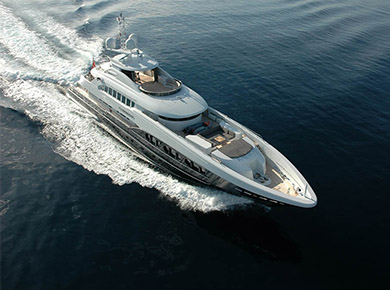
Find your Yacht
Find your destination.
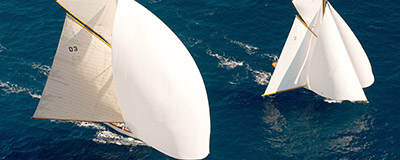
Buy a Yacht
Share a yacht, yacht investment.
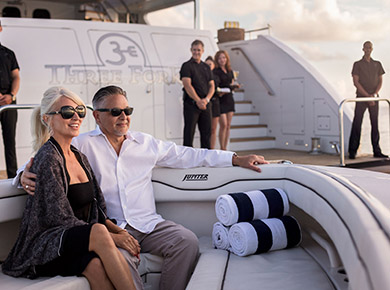
Find relevant Management Services

- +41 78 226 17 10
- Seestrasse 39 · 9326 Horn · Switzerland
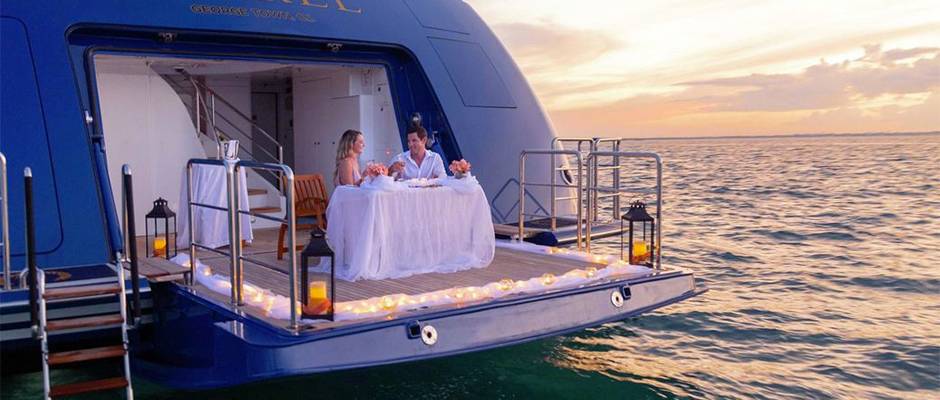
Our Policies
December 5, 2022
A brief history of the famous “12 metre” class yachts.
The 12 Metre Class is a gorgeous showpiece on the regatta courses, both an ultimate cruising machine and an inshore prestige sled. Like capricious horses, the “12 Metres” have concise, beautifully short names. They are called “Anita”, “Anitra”, “ Cintra “, “Evaine”, “Flica”, “Heti”, “Sphinx”, “Thea”, “ Trivia “, “Vanity” or “Vim”. They are elegant, slender, and about 20 meters long. With their 30 tons of combat weight, they are true regatta warhorses. One should have sailing skills in order to compete with these bolides in fresh winds on the regatta course. Today, as the progressive sailing scene takes to the skies, kiting, surfing, and low-drag hydrofoiling across the water with ultra-light, high-tech bullets, the lead-heavy long keels seem more old-fashioned than ever. About a hundred of the 170 built still exist, see a list here . The most beautiful 12 Metres, the scene agrees, are the classic long-keeled ships of the thirties. But there are also lovers of modern designs, who is enthusiastic about Philippe Briand’s 1985 design “ French Kiss ” and sail it in the Mediterranean.
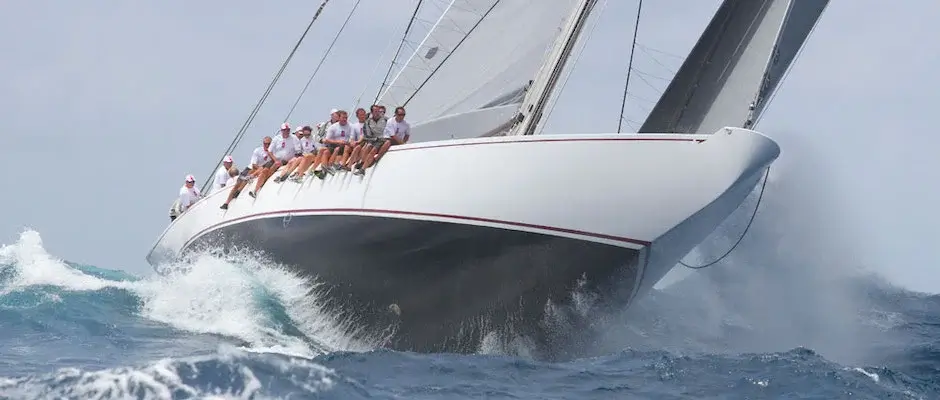
Historic Yachts
There is even a shipyard specializing in 12 Metres classes. At Robbe & Berking Classics, a completely new 12-Metre will soon be completed according to plans by Johan Anker from 1939, known as No. 434 . The Flensburg shipyard also has the Australian “ Gretel ” from 1962 and the recently restored English “ Jenetta ” from 1939.
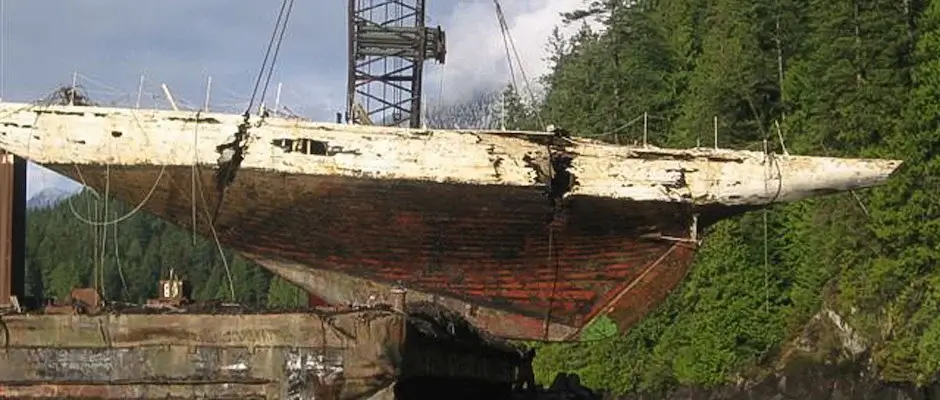
Fascination 12mR
There are three reasons for the fascination for a „12 Metre” or “12mR”: a historical one, an aesthetic one and, most importantly, the sailing one. The nimbus derives from its function as a former America’s Cup class. Sailing history was written with the „12 metre” from 1958 off Newport to 1987 off Fremantle, Australia. The best yacht designers, boat and mast builders, hardware manufacturers, sailmakers, savvy sailors and shrewd tacticians competed in the class back then.
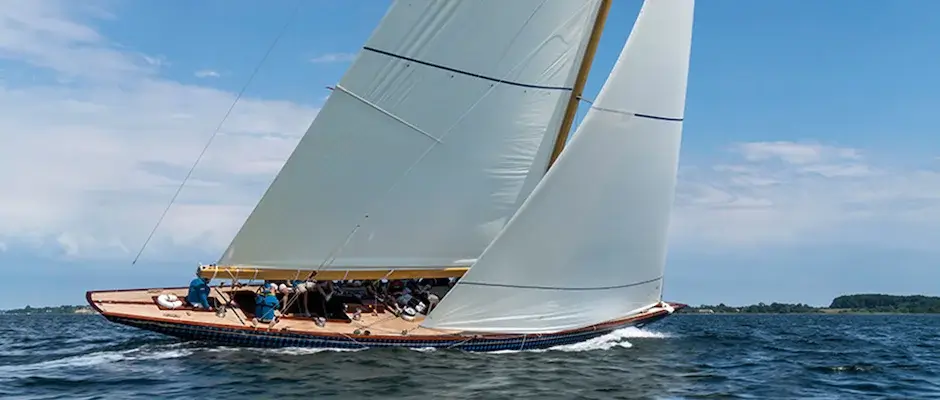
Elegant Beauties
The boats, especially the long-keeled examples of the thirties are elegant. You can look at them for a long time, from the massive stem to the stern that is lifted apart from the water.
And they are true thoroughbreds. It is an addictive pleasure to sail them. There is no other type of boat that takes to the wind with comparable frenzy and is similarly unyielding through the water. With nearly 30 tons and about 15 tons of lead under the bottom cheeks, the twelve-footer has a lot of power. Hardly any other class is built closer to the water and offers
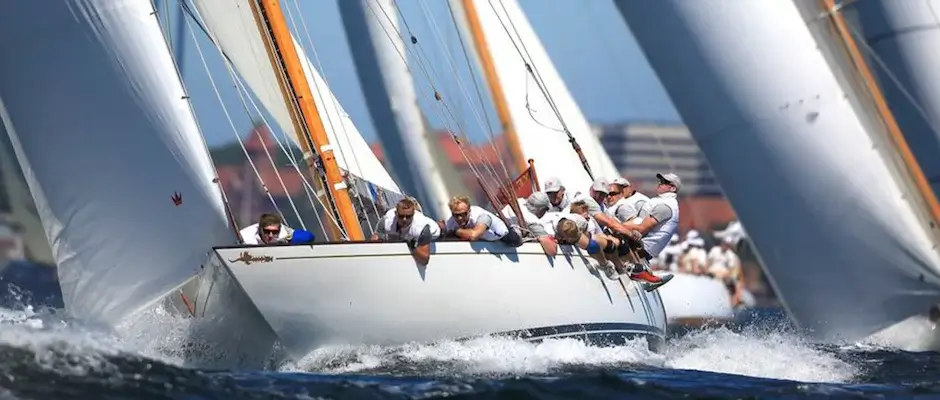
But let’s tell the story from the beginning
America’s Cup contenders between 1958 and 1987 – the 12 Metre Class
Following a twenty-one-year hiatus, the America’s Cup resumed in 1958 with a new class of boats, the 12-Metre Class. Smaller in size, easier to crew, and more manageable on a race course, these 60 to 70-foot sloops were an improvement over the previous 135-foot America’s Cup racing class, the “J” boats. Like the “J” boats, the “12 Metre” class was designed according to a formula. In other words, “12 Metre” Class yachts can have a wide range of sail area, length, and speed production aspects. All “12 Metre” yachts are measured using the following mathematical formula:

This formula inputs the speed-producing factors: (length (L), sail area (Sa), freeboard (F), and girth measurement (2D). Yachts that meet this formula must not exceed 12 metres in length. Other restrictions on the design measurements of “12-Metre” racing yachts are in place to prevent one design from being vastly superior to another and to ensure a fair and competitive racing environment. In order to ensure that “12 metre” racing yachts do not differ too much, maximum and minimum mast heights, drafts, beams, and headsails are used.
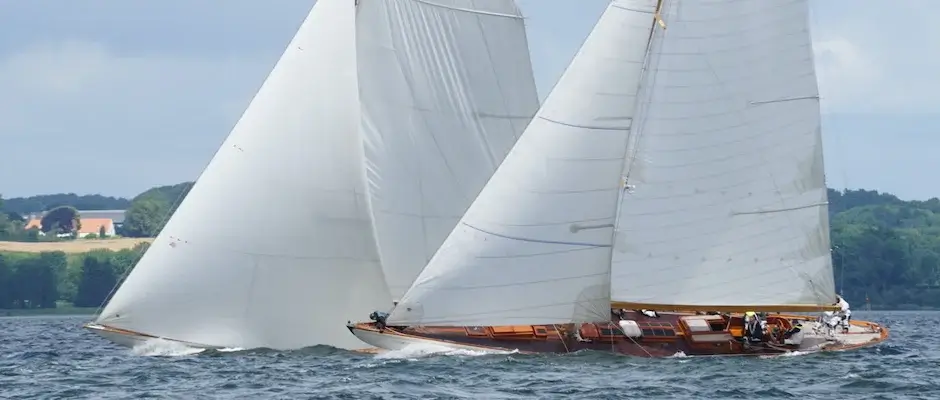
International Rules
“12 Metre” yachts are probably the most fascinating racing yachts ever built. With their beauty and size, along with their America’s Cup history, they have attracted and intrigued yachtsmen since they were first launched. Powered by their massive sail areas, these 30 tons racing beauties reach speeds as high as twelve knots. They have main sails that are approximately 1200 square feet in size and jibs that range from 500 square feet to over 1200 square feet in size, with a height that cannot exceed 75 percent of the mast. Until 1958, “12 Metre” yachts were not raced in the America’s Cup. Nevertheless, the six, eight, and twelve metre rules date back over five decades. The International Rules for metre class boats were developed in 1906 by William Froude and the Royal Yachting Association in England. The “12 Metre” boats had significant racing success prior to their America’s Cup debut and were used in the 1908, 1912, and 1920 Olympic games.
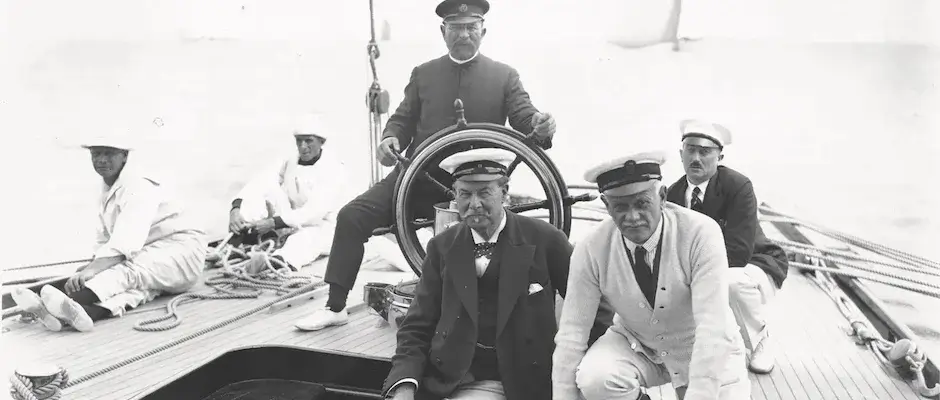
The America’s Cup, the oldest Trophy
American yachtsmen first took up the 12 Metre Class in 1928 when they ordered six nearly identical boats from Starling Burgess, the renowned boat designer. It was in 1939 that American 12 Metre racing was elevated to a new level when Harold Vanderbilt, an accomplished America’s Cup sailor, “J” boat skipper, and the winner of the 1930, 1934, and 1937 America’s Cup, brought his new 12 Metre, the “Vim” (12 Metre US-15), to England for a race against the Royal Yacht Squadron. The Royal Yacht Squadron was in awe of “Vim” after she won 21 of 27 races against British 12 Metres while in England. From 1958 until 1958, “Vim” remained the standard by which all other 12 Metre yachts were measured until “Columbia” (12 Metre US-16) defeated her in the tie-breaking race of the America’s Cup defense trials by only 12 seconds. It would be the design standard for America’s Cup racing yachts until 1987, when it was retired.
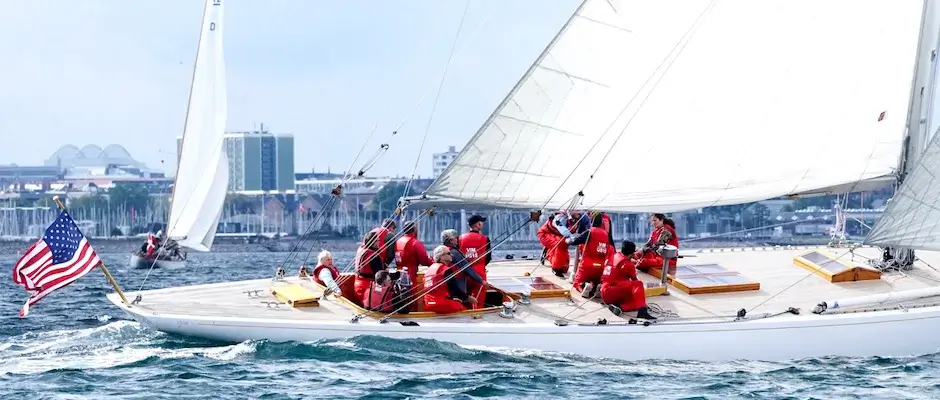
The Auld Mug
“12 metres” were designed with one thing in mind – to win America’s Cup races. The design of their products reflects this in every aspect. America’s Cup twelves didn’t have room for an engine, anything below decks, or even a toilet when they were campaigning. The deck layouts of America’s Cup twelves are set up for optimal sail performance as well as for speed. When racing, the sails are the engine of the boat, so trimming them correctly and quickly was crucial to winning. America’s Cup “12 Metre” crews were also trained for efficiency. When it was their turn to compete in the famous America’s Cup, they had intensive training and practice to be flawless at sail handling and the best yacht racers in the world.
Despite their demise, America’s Cup “12 Metre” boats remain one of the most prestigious racing classes in the America’s Cup history. Many twelves have gone on to have successful ocean racing careers after their America’s Cup adventures. The largest fleet of “12 metre” boats in the world resides in Newport, Rhode Island, where over 50 years of America’s Cup racing have taken place.
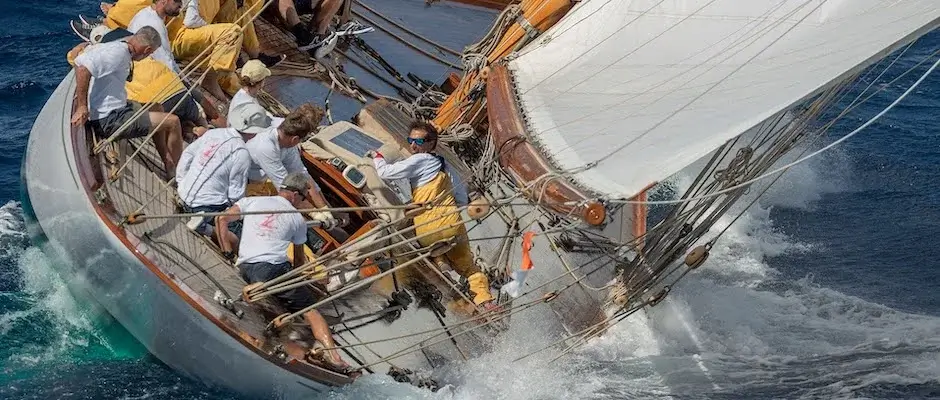
During the summer months of August and October, many of these classic racers attend numerous sailing events on the French Riviera . Noblesse Yachts is the only company that offers sailing opportunities as well as yacht charters.
Come sail with us on a piece of America’s Cup racing history on these sleek racing beauties!
Available Dates are: 07.09. – 10.09.23: Vele d’Epoca di Imperia ( See Video here ) 13.09. – 16.09.23: Monaco Classic Week ( See Video here ) 19.09. – 25.09.23: Les Regates Royales de Cannes ( See Video here ) 24.09. – 08.10.23: Les Voiles de Saint Tropez ( See Video here )
Note about copyright: This text is copyrighted by us and you may copy and use it only with a link to our website along with a clear indication of our authorship. Thank you!
#classicyacht #veledepoca # monacoclassicweek #adrenaline #regatesroyles #lesvoilesdesainttropez #sainttropez #cannes #monaco #12metre #racing #racingyacht #americascup #12mR-Class, #12mRClass, #12mRWorldChampionship, #12mRWorlds, #JohanAnker, #TheaD-1, #VanityVK-5, #VimUS-15, #WingsK-15, 12mR racing, #noblesse #noblesseyachts #luxurycharter #luxuryyachts #boatrental #travelwithstyle #holiday2022 #yachtlife #yachtworld #yachtlover #sailaway #holidayescape #timeofmylife

Sustainable Corporate Events: Charting a Greener Future
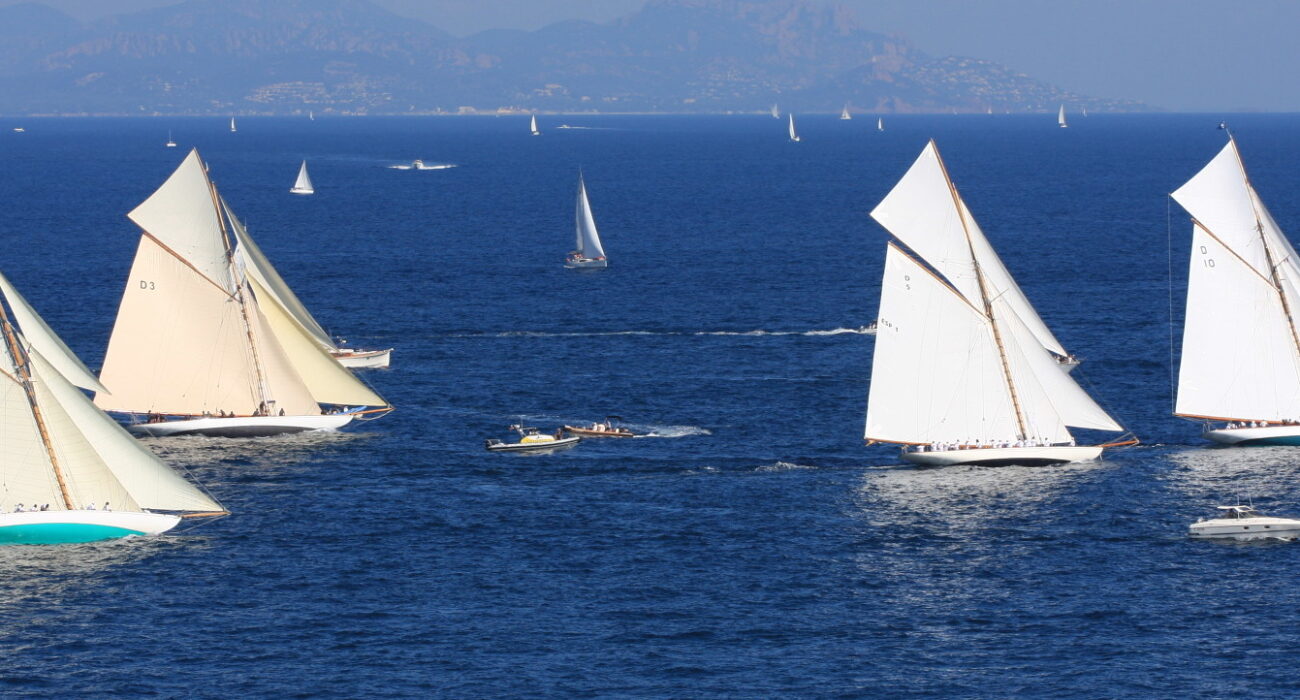
The 15-Metre Class Yachts: A Historical Overview
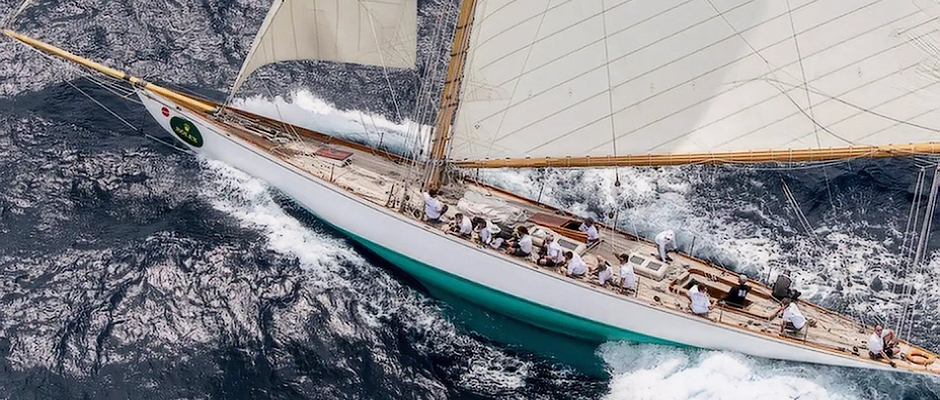
Exploring the Timeless Elegance of Mariska: A Classic Yacht’s Journey Through History
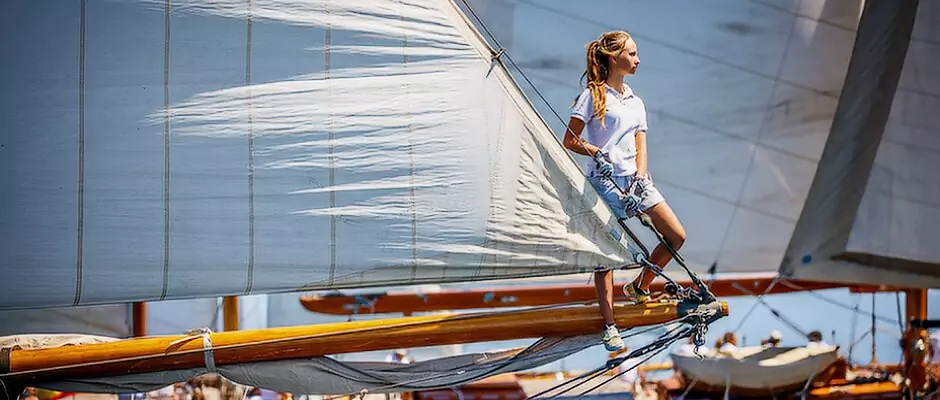
Your Regatta 101 Guide for Participating with your own Boat

A Journey Through The Argentario Sailing Week: Sailing the Spectacular!

2024 Sailing’s Grand Spectacle: The 37th America’s Cup Roars into Barcelona with a Classic Twist
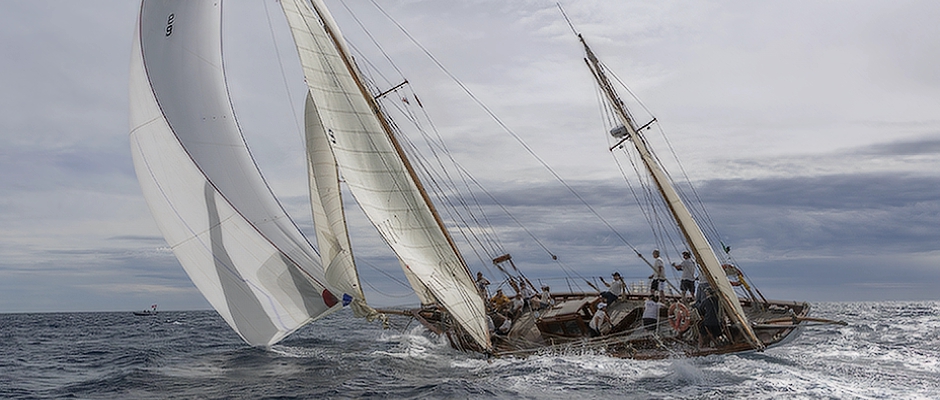
1890’s Masterpiece: Yacht SKY’s Timeless Voyage
- Privacy Policy
- Cookie Policy
This website uses cookies to ensure the best experience. Read more.

- Meet the ITMA Team
- Class Rules
- Class By-Laws
- 12mR Database
- Measurement Certificates
- The 12mR Class by Luigi Lang & Dyer Jones- Volume 1
- The 12mR Class by Luigi Lang & Dyer Jones- Volume 2
- 2024 PORQUEROLLES
- 2023 NEWPORT
- 2021 HELSINKI
- 2019 NEWPORT
- 2014 BARCELONA
- 2011 FLENSBURG
- WORLD CHAMPIONS
- 2017-2019 Series
- 2021 Regattas
- 2020 Regattas
- 2019 Regattas
- 2018 Regattas
- 2017 Regattas
- 2016 Regattas
- 2015 Regattas
- 2014 Regattas
- 2013 Regattas
- 2012 Regattas
- 2011 Regattas
- AMERICAS FLEET
- NORTHERN EUROPE FLEET
- SOUTHERN EUROPE FLEET
- Americas Fleet
- N. Europe Fleet
- S. Europe Fleet
- Coupe de France Series
- 12mRs for Sale
- 12mRs for Charter
- 12mR Brand Guide
- 12mR Team Store
Gleam, US-11

Built in 1937 according to the International Third Rule.
1937-1942: Clinton Crane built Gleam for his own use using an innovative method of tank testing against Seven Seas . She had a new lead keel in 1939 and was also dismasted that year. Her mast was replaced with one built for Vim . Crane shared the findings of his extensive testing with Olin Stephens and Francis Herreshoff. She won the Astor Cup (NYYC) in 1937.
1943-1952: Gleam was purchased by B. Devereaux Barker and B. Devereaux Barker Jr. of Marblehead, MA– they installed an engine in 1940. In 1950 John N. Potter of Darien, CT purchased Gleam , renamed her Charlotte II and replaced her engine.
1953-1975: W. Mahlon Dickerson purchased, restored her name to Gleam and brought her home to Oyster Bay, NY. She was the trial horse for Vim and Sceptre in the 1958 America’s Cup and for Gretel in the 1962 Cup.
1975-2019: Robert Tiedemann (now deceased) purchased Gleam and brought her to Newport, RI. He gave her a full restoration and a new engine. Tiedemann is often credited for the rebirth of the 12 Metre Fleet in Newport, RI as we know it today. After his death, his widow Elizabeth Tiedemann DuPont continued to charter US-11 through their company Seascope Yacht Charters in Newport, RI.
2020: Gleam was purchased by Andy Tyska of Bristol Marine who will undertake a major refit at their Boothbay Harbor (ME) Shipyard. During the winter of 2020 her hull will be repaired enabling her to sail in Maine waters during the summer of 2021. The following winter (2021), she is set to receive a new deck and a restoration of her elegant interior. If all goes to plan, she will return Newport for the 2022 sailing season.
*Content courtesy: The Twelve Metre Class by Dyer Jones & Luigi Lang
Jump to Twelve Metre Yacht Club, Newport Station Fleet page for Gleam (US-11)


IMAGES
VIDEO
COMMENTS
The 115 year-old International 12 Metre Class encompasses a living history of racing yacht design by the world's foremost naval architects including Olin Stephens, Clinton Crane, William Fife III, Philip Rhodes, Johan Anker, Ben Lexcen and more who pushed their designs to the very limits of innovation. ... Gretel, KA-1. Built in 1962 ...
The 12mR yacht "Gretel" sailed as a challenger for the America's Cup in 1962 and was the first Australian 12-metre ever, designed by Alan Payne. The boat was far quicker than the defending "Weatherly" designed by Philip Rhodes, and indeed won, the first challenger after the race between "Endeavour" and "Rainbow" at an AC competition in 1934 ...
Spotted on the courtyard of Robbe & Berking Classics; Gretel, a piece of America's Cup history. This legendary 12-metre yacht has had a long journey so far, from Australia via the United States and Italy to Flensburg. In 1962 she was the boat of the Australian challenger, Sir Frank Packer, but she was sailed by Jock Sturrock and was the ...
Gretel II. Gretel II (KA-3) is an International 12-metre class racing yacht built for the America's Cup challenge series in 1970. She was designed by Alan Payne and built by W.H. Barnett for Australian media tycoon Sir Frank Packer . Packer had first challenged for the America's Cup in 1962 with the yacht Gretel, which was named after his wife.
The 12-m-R yacht GRETEL sailed as a challenger for the America's Cup in 1962. It was the first ever Australian 12mR. GRETEL was designed by the yacht designer Alan Payne. Her hull was built of wood on steel frames. The 12 metre designed by Alan Payne was full of new ideas.
The 115 year-old International 12 Metre Class encompasses a living history of racing yacht design by the world's foremost naval architects including Olin Stephens, Clinton Crane, William Fife III, Philip Rhodes, Johan Anker, Ben Lexcen and more who pushed their designs to the very limits of innovation. ... Gretel II, KA-3. Gretel, KA-1. Guri ...
Gretel II, the famous Australian yacht that might well have won the America's Cup in 1970, turned 50 today, the classic 12-Metre Class yacht sitting sedately in her marina berth at the Royal Yacht Club of Tasmania on Hobart's River Derwent. Gretel II was launched in Sydney on April 10 in 1970 for media magnate Sir Frank Packer, built by ...
In 2010 GRETEL II takes part in races on the Harbour and is planning to sail to events outside of NSW in the coming year. Significance GRETEL II is the Australian America's Cup 12 metre class yacht built to challenge for the America's Cup series in 1970. It lost the series to the American defender INTREPID 4-1 in controversial circumstances ...
Gretel II, the famous Australian yacht that might well have won the America's Cup in 1970, turned 50 today, the classic 12-Metre Class yacht sitting sedately in her marina berth at the Royal Yacht Club of Tasmania on Hobart's River Derwent. Gretel II was launched in Sydney on this day 197 for media magnate Sir Frank Packer, built by Bill ...
The oldest footage of 12 Metre class yachts by Magnus Smith We delve into the past, and round-up all the videos which show sailing in the 12 Metre class of yacht. We delve into the past, and round-up all the videos which show sailing in the 12 Metre class of yacht. Posted 24 Dec 2023
Getting Gretel home to the Royal Sydney Yacht Club wasn't a case of simply setting sail off into the wild blue yonder. 12-meter yachts are designed for inshore match racing, not ocean crossings. So to get it home half-way around the world they had to load it on a freighter and ship it back.
Gretel II (KA-3) is an International 12-metre class racing yacht built for the America's Cup challenge series in 1970. She was designed by Alan Payne and built by W.H. Barnett for Australian media tycoon Sir Frank Packer.
1962 WEATHERLY vs. GRETEL 1964 CONSTELLATION vs. SOVEREIGN 1967 INTREPID vs. DAME PATTIE 1970 INTREPID vs. GRETEL II 1974 COURAGEOUS vs. SOUTHERN CROSS 1977 COURAGEOUS vs. AUSTRALIA ... AUSTRALIA II was the best 12-Metre yacht to sail in the 25-year history of competition at Newport. Her extraordinary and controversial winged keel was, of ...
Yr. Launched Launched Name Designer Builder; AUS 01: KA-1: 1962: Gretel: Alan Payne: Lars Holvorsen Sons. Pty. Ltd. AUS 02: KA-2: 1966: Dame Pattie: Warwick J. Hood
Gretel; Yacht club Royal Sydney Yacht ... Sir Frank Packer: Racing career; Skippers: Jock Sturrock: Gretel is an Australian racing yacht in the 12-metre class that unsuccessfully challenged for the 1962 America's Cup. Gretel lost to Weatherly by 1-4. References This page was last edited on 19 November 2022, at 22:40 ...
Historic Yachts. There is even a shipyard specializing in 12 Metres classes. At Robbe & Berking Classics, a completely new 12-Metre will soon be completed according to plans by Johan Anker from 1939, known as No. 434.The Flensburg shipyard also has the Australian "Gretel" from 1962 and the recently restored English "Jenetta" from 1939.
The 115 year-old International 12 Metre Class encompasses a living history of racing yacht design by the world's foremost naval architects including Olin Stephens, Clinton Crane, William Fife III, Philip Rhodes, Johan Anker, Ben Lexcen and more who pushed their designs to the very limits of innovation. ... Gretel II, KA-3. Built in 1970 ...
History & Design of the 12-Meter Yachts. Over 100 years ago the 12-Meter yachts first set sail. So why are they still recognized as the standard for design, speed, and agility? Originally built in 1907, the 12-Meter boats first appeared in America's Cup in 1958 when the competition resumed after a 21 year halt due to World War II. These boats ...
The 115 year-old International 12 Metre Class encompasses a living history of racing yacht design by the world's foremost naval architects including Olin Stephens, Clinton Crane, William Fife III, Philip Rhodes, Johan Anker, Ben Lexcen and more who pushed their designs to the very limits of innovation. ... Trial-horse Gretel II for the 1970 ...
Pages in category "12-metre class yachts" The following 41 pages are in this category, out of 41 total. This list may not reflect recent changes. * List of 12-metre yachts; A. ... Gretel (yacht) Gretel II; H. Heart of America (yacht) I. Intrepid (yacht) Italia (yacht) K. Kookaburra II; Kookaburra III; Kiwi Magic; L. Liberty (yacht) N. New ...
Half block model of GRETEL II. Sydney, NSW, Australia, 1991. Jelutong wood coated with sanding sealer, primer and automotive lacquer. Object is a hal... Australian National Maritime Museum. ... This builder's half block model was made by Frank Allen after the 12-metre yacht, GRETEL II.
The 115 year-old International 12 Metre Class encompasses a living history of racing yacht design by the world's foremost naval architects including Olin Stephens, Clinton Crane, William Fife III, Philip Rhodes, Johan Anker, Ben Lexcen and more who pushed their designs to the very limits of innovation. ... she won the Defender Trails and the ...
She was the trial horse for Vim and Sceptre in the 1958 America's Cup and for Gretel in the 1962 Cup. 1975-2019 ... He gave her a full restoration and a new engine. Tiedemann is often credited for the rebirth of the 12 Metre Fleet in Newport, RI as we know it today. ... Jump to Twelve Metre Yacht Club, Newport Station Fleet page for Gleam (US ...